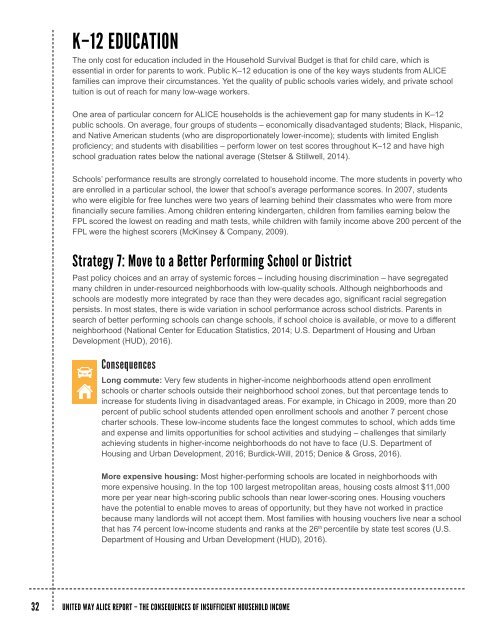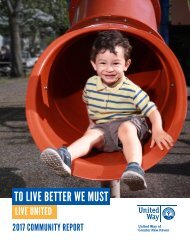The Consequences of Insufficient Household Income
This new Consequences of Insufficient Household Income report provides a deeper level of understanding of the choices that ALICE and poverty-level families across the country make when they do not have enough income or assistance to afford basic necessities, and the consequences of those choices.
This new Consequences of Insufficient Household Income report provides a deeper level of understanding of the choices that ALICE and poverty-level families across the country make when they do not have enough income or assistance to afford basic necessities, and the consequences of those choices.
Create successful ePaper yourself
Turn your PDF publications into a flip-book with our unique Google optimized e-Paper software.
K–12 EDUCATION<br />
<strong>The</strong> only cost for education included in the <strong>Household</strong> Survival Budget is that for child care, which is<br />
essential in order for parents to work. Public K–12 education is one <strong>of</strong> the key ways students from ALICE<br />
families can improve their circumstances. Yet the quality <strong>of</strong> public schools varies widely, and private school<br />
tuition is out <strong>of</strong> reach for many low-wage workers.<br />
One area <strong>of</strong> particular concern for ALICE households is the achievement gap for many students in K–12<br />
public schools. On average, four groups <strong>of</strong> students – economically disadvantaged students; Black, Hispanic,<br />
and Native American students (who are disproportionately lower-income); students with limited English<br />
pr<strong>of</strong>iciency; and students with disabilities – perform lower on test scores throughout K–12 and have high<br />
school graduation rates below the national average (Stetser & Stillwell, 2014).<br />
Schools’ performance results are strongly correlated to household income. <strong>The</strong> more students in poverty who<br />
are enrolled in a particular school, the lower that school’s average performance scores. In 2007, students<br />
who were eligible for free lunches were two years <strong>of</strong> learning behind their classmates who were from more<br />
financially secure families. Among children entering kindergarten, children from families earning below the<br />
FPL scored the lowest on reading and math tests, while children with family income above 200 percent <strong>of</strong> the<br />
FPL were the highest scorers (McKinsey & Company, 2009).<br />
Strategy 7: Move to a Better Performing School or District<br />
Past policy choices and an array <strong>of</strong> systemic forces – including housing discrimination – have segregated<br />
many children in under-resourced neighborhoods with low-quality schools. Although neighborhoods and<br />
schools are modestly more integrated by race than they were decades ago, significant racial segregation<br />
persists. In most states, there is wide variation in school performance across school districts. Parents in<br />
search <strong>of</strong> better performing schools can change schools, if school choice is available, or move to a different<br />
neighborhood (National Center for Education Statistics, 2014; U.S. Department <strong>of</strong> Housing and Urban<br />
Development (HUD), 2016).<br />
<strong>Consequences</strong><br />
Long commute: Very few students in higher-income neighborhoods attend open enrollment<br />
schools or charter schools outside their neighborhood school zones, but that percentage tends to<br />
increase for students living in disadvantaged areas. For example, in Chicago in 2009, more than 20<br />
percent <strong>of</strong> public school students attended open enrollment schools and another 7 percent chose<br />
charter schools. <strong>The</strong>se low-income students face the longest commutes to school, which adds time<br />
and expense and limits opportunities for school activities and studying – challenges that similarly<br />
achieving students in higher-income neighborhoods do not have to face (U.S. Department <strong>of</strong><br />
Housing and Urban Development, 2016; Burdick-Will, 2015; Denice & Gross, 2016).<br />
More expensive housing: Most higher-performing schools are located in neighborhoods with<br />
more expensive housing. In the top 100 largest metropolitan areas, housing costs almost $11,000<br />
more per year near high-scoring public schools than near lower-scoring ones. Housing vouchers<br />
have the potential to enable moves to areas <strong>of</strong> opportunity, but they have not worked in practice<br />
because many landlords will not accept them. Most families with housing vouchers live near a school<br />
that has 74 percent low-income students and ranks at the 26 th percentile by state test scores (U.S.<br />
Department <strong>of</strong> Housing and Urban Development (HUD), 2016).<br />
32 UNITED WAY ALICE REPORT – THE CONSEQUENCES OF INSUFFICIENT HOUSEHOLD INCOME




